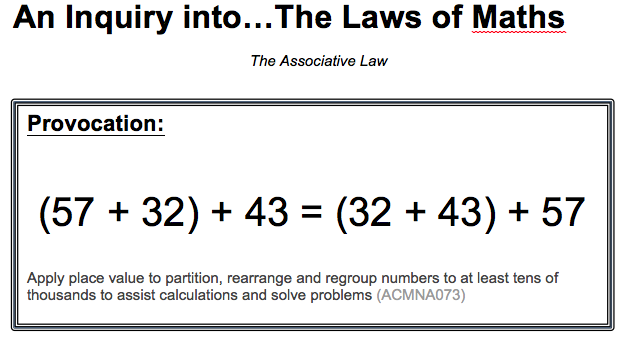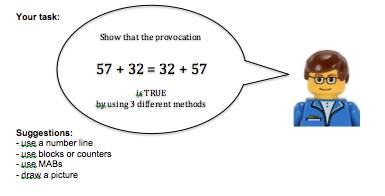Today we had a look at how the Associative Law relates to addition. It wasn't an inspiring exercise - it was after lunch, it was hot, the kids were tired and so was I. Also, it wasn't that different from what we did yesterday, as one student quickly pointed out.
So I really have to commend the class for the great things they came up with.
Our provocation here looked at what happens when you are adding more than two numbers together. I chose to use 2-digit numbers as practice for my new class, to see what their addition skills were like at the same time as investigating the Associative Law. (happy to report - skills pretty good!)
Just like yesterday when we looked at the Commutative Law, I was keen for the kids to present multiple strategies to prove the provocation was correct. This time I suggested using balance scales as one option. I was wanting to promote the idea that "=" is not the "here comes the answer" sign but is in fact the "that side equals/is the same as this side" sign.
So, when we sat down and got out the gear, the kids started to produce some interesting ideas to prove the provocation was true.
Here are some of the ideas they came up with:
The number line is always a good choice. I can see the numbers used as the starting point but not the individual numbers that are added to it, only the combined value of the other two numbers: 75 (= 32 + 43) and 100 (= 43 + 57)
Another number line. This time the jumps use the individual addends without breaking them down into smaller parts. The top number line shows the combinations of each pair of numbers when added. This is applied to the bottom number line to show what happens when you start with each of the three numbers and how all combinations end up at 132.
Using tally marks is a slow process but it shows that you end up with the same value regardless of the order in which you write them.
And here is the story of Tom, Tim and Terry. They stand on each other's heads and still achieve the same combined height, which isn't very tall - only 132mm. Great use of length to show how to add numbers.
Ahh...here's the balance scales. If you count out the value of each number using the Base-10 material and put them into either side of the scales, it balances out. One of my favourite ways to demonstrate equality.
I saved this one for last because it is intriguing. The target total (132) is written in the centre triangle. At each corner are the three numbers from the provocation - 43, 32 and 57. Then between each of these numbers is the sum of the pairs:
57 + 32 = 89; 32 + 43 = 75; 57 + 43 = 100
Then if you follow the lines around the outside you can see what numbers will combine to equal 132.
I'm not sure where this boy got this idea - but I like it!
So - lots of fun. Not sure where we head tomorrow. The plan is to start to mess with their heads and introduce subtraction into the Commutative and Associative Laws...




















